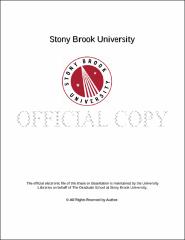| dc.identifier.uri | http://hdl.handle.net/11401/77109 | |
| dc.description.sponsorship | This work is sponsored by the Stony Brook University Graduate School in compliance with the requirements for completion of degree. | en_US |
| dc.format | Monograph | |
| dc.format.medium | Electronic Resource | en_US |
| dc.language.iso | en_US | |
| dc.publisher | The Graduate School, Stony Brook University: Stony Brook, NY. | |
| dc.type | Dissertation | |
| dcterms.abstract | Carbon nanotubes have attracted a great deal of research interest because they have potential applications in many different areas, such as nanoprobes, molecular reinforcements in composites, displays, sensors, energy-storage media, and molecular electronic devices. Chemists have considered this a challenge as they have made many attempts to design and synthesize their own imaginative versions of tubular molecules. The first section is the investigation of a directed and controlled approach for the synthesis of nanotubes held together via covalent bonds. Numerous tubular molecules have been prepared by the self-assembly of a wide variety of substrates, via hydrogen bonds, π − π stacking or Van der waals contacts. Tubular structures held together by covalent bonds have also been studied for a long time. In our group we have been focusing upon designed topochemical polymerization reactions of diacetylenes. Based on this idea, the series of compounds were synthesized as the polymerizable diacetylene macrocycles that would self-assemble in accordance with the parameters needed for a topochemical polymerization. The second section is the preparation of the non-covalent bonded organic nanotubes with guest accessible cahnnels by utilizing the intermolecular oxalimide-oxalimide interactions. The ultimate goal of this work is to design artificial cavities that can direct diacetylene polymerization reactions with comparable levels of selectivity. The series of compounds were designed and synthesized to self-assemble at the desired distance of 4.9 Å, which is essential to align the diacetylene guest molecules at a distance required for the topochemical polymerization. As a result, the desired polymer will be obtained by heating or UV irradiation. | |
| dcterms.abstract | Carbon nanotubes have attracted a great deal of research interest because they have potential applications in many different areas, such as nanoprobes, molecular reinforcements in composites, displays, sensors, energy-storage media, and molecular electronic devices. Chemists have considered this a challenge as they have made many attempts to design and synthesize their own imaginative versions of tubular molecules. The first section is the investigation of a directed and controlled approach for the synthesis of nanotubes held together via covalent bonds. Numerous tubular molecules have been prepared by the self-assembly of a wide variety of substrates, via hydrogen bonds, π − π stacking or Van der waals contacts. Tubular structures held together by covalent bonds have also been studied for a long time. In our group we have been focusing upon designed topochemical polymerization reactions of diacetylenes. Based on this idea, the series of compounds were synthesized as the polymerizable diacetylene macrocycles that would self-assemble in accordance with the parameters needed for a topochemical polymerization. The second section is the preparation of the non-covalent bonded organic nanotubes with guest accessible cahnnels by utilizing the intermolecular oxalimide-oxalimide interactions. The ultimate goal of this work is to design artificial cavities that can direct diacetylene polymerization reactions with comparable levels of selectivity. The series of compounds were designed and synthesized to self-assemble at the desired distance of 4.9 Ã…, which is essential to align the diacetylene guest molecules at a distance required for the topochemical polymerization. As a result, the desired polymer will be obtained by heating or UV irradiation. | |
| dcterms.available | 2017-09-20T16:51:59Z | |
| dcterms.contributor | Goroff, Nancy | en_US |
| dcterms.contributor | Fowler, Frank W. | en_US |
| dcterms.contributor | Mayr, Andreas | en_US |
| dcterms.contributor | Lauher, Joseph W. | en_US |
| dcterms.contributor | Lee, Linwood. | en_US |
| dcterms.creator | Hsu, Te-Jung | |
| dcterms.dateAccepted | 2017-09-20T16:51:59Z | |
| dcterms.dateSubmitted | 2017-09-20T16:51:59Z | |
| dcterms.description | Department of Chemistry. | en_US |
| dcterms.extent | 247 pg. | en_US |
| dcterms.format | Application/PDF | en_US |
| dcterms.format | Monograph | |
| dcterms.identifier | http://hdl.handle.net/11401/77109 | |
| dcterms.issued | 2015-08-01 | |
| dcterms.language | en_US | |
| dcterms.provenance | Made available in DSpace on 2017-09-20T16:51:59Z (GMT). No. of bitstreams: 1
Hsu_grad.sunysb_0771E_11600.pdf: 8737678 bytes, checksum: 434615c21ff51523147c8d87c37bc02c (MD5)
Previous issue date: 2013 | en |
| dcterms.publisher | The Graduate School, Stony Brook University: Stony Brook, NY. | |
| dcterms.subject | Chemistry | |
| dcterms.title | Preparation of the Organic Nanotubes | |
| dcterms.type | Dissertation | |

